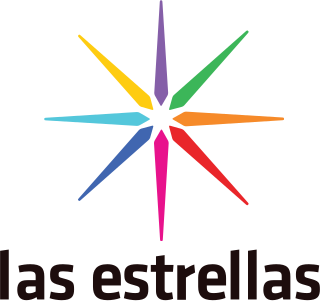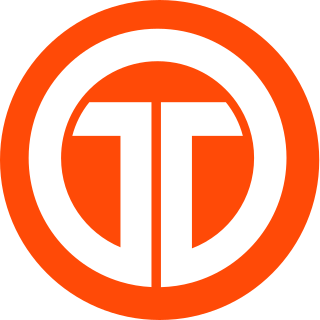Public broadcasting involves radio, television, and other electronic media outlets whose primary mission is public service. Public broadcasters receive funding from diverse sources including license fees, individual contributions, public financing, and commercial financing, and claim to avoid both political interference and commercial influence.

Televisión Nacional de Chile (TVN) is a Chilean public service broadcaster. It was founded by order of President Eduardo Frei Montalva and it was launched nationwide on 18 September 1969. Since then, the company has been reorganized on several occasions and its operations areas have increased over the years, becoming one of the leading television broadcasters in Chile and South America. Law 17 377 of 1970 established that TVN must be a public, autonomous, pluralistic, and representative public service. TVN's public mission determines the obligation to promote the national cultural identity, the values of democracy, human rights, care for the environment and respect for diversity. Furthermore, Televisión Nacional governs the programming of its services according to criteria established by the National Television Council (CNTV).

Canal 13 is a Chilean free-to-air television network. Informally known in Chile as El 13, it is the second oldest television station in the country. Launched on August 21, 1959, on VHF channel 2 in Santiago, it was founded by a group of engineers from the Pontifical Catholic University of Chile. The station later moved its frequency to VHF channel 13, which gave rise to its current name. One of its most significant milestones was broadcasting the 1962 FIFA World Cup, hosted in Chile.

Telecinco is a Spanish free-to-air television channel operated by Mediaset España. The channel was previously known as Tele 5, because it had first begun its experimental transmissions on 10 March 1989, and a year later, it was officially launched on 3 March, 1990, becoming the fifth of the national terrestrial television channels and the second private channel in Spain. In 1997, Tele 5 was rebranded as Telecinco, dropping the biscione-absent flower logo seen in other Mediaset channel logos.

Once is a Mexican educational broadcast television network owned by National Polytechnic Institute. The network's flagship station is XEIPN-TDT channel 11 in Mexico City. It broadcasts across Mexico through nearly 40 TV transmitters and is required carriage on all Mexican cable and satellite providers. The network also operates an international feed which is available in the United States and Venezuela via satellite from DirecTV and CANTV, via online from VEMOX, VIVOplay and also on various cable outlets, on "Latino" or "Spanish" tiers. Most of its programs are also webcast through the Internet, though its programming is not the same as the actual broadcasters or satellite signal.

La Red, is a private television channel in Chile. It began broadcasting on 12 May 1991, as the second private television station in Chile, after Mega.
Cuatro is a Spanish free-to-air television channel that was launched in November 2005. Owned by Mediaset España, the Spanish subsidiary of the Italian Mediaset group, it is broadcast on TV frequencies licensed to the previous owner PRISA TV in 1990 and previously used by them for the analogue transmission of its pay-per-view channel Canal+.
Channel 2 or TV 2 may refer to:
Cuba was the first Latin American country to begin television testing in December 1946 when station CM-21P conducted an experimental multi-point live broadcast. The first regular commercial broadcasting began in October 1950 by the small radio station Union Radio, soon followed by other stations. The broadcasts featured sport, soap operas, news, cooking shows, and comedy. Censorship was imposed following the 1952 coup by Fulgencio Batista, and again by the government of the Cuban revolution after their victory in 1959.

A multiplex or mux, also known as a bouquet, is a grouping of program services as interleaved data packets for broadcast over a network or modulated multiplexed medium, particularly terrestrial broadcasting. The program services are broadcast as part of one transmission and split out at the receiving end.

TVMax is a commercial privately owned TV station in Panama City, Panama that is available all over the country. It is owned by TVN Media which owns flagship and sister channel TVN
Television in Spain was introduced in 1956, when the national state-owned public service television broadcaster Televisión Española (TVE) started regular analog free-to-air terrestrial black and white broadcasts. Colour transmissions started in 1972 after two years of test transmissions, with all programming transmitted in color in 1977, and colour commercials starting in 1978. TVE held a monopoly on television broadcasting until regional public channels were launched during the 1980s and commercial television started nationwide in 1990. Digital terrestrial television was launched on 30 November 2005 with analog service discontinued on 3 April 2010. Currently, television is one of the leading mass media of the country, and by 2008 was in 99.7% of households in Spain according to INE statistics.

Televisora Nacional, also known as TVN is a television network headquartered in Panama City, Panama, with repeaters throughout the country. The stations broadcast in the NTSC format and DVB-T for Panama City. In DVB-T format it was the only TV station in HD for most of the day and they also broadcast in a sub-channel two hours behind programming from the main channel(DVB-T only), being the first TV station to have this service.

Las Estrellas is one of the cornerstone networks of TelevisaUnivision, with affiliate stations all over Mexico, flagshipped at XEW-TDT in Mexico City. Many of the programs of Las Estrellas are seen in the United States on Univision, UniMás, and Galavisión.

Boing is a Spanish free-to-air television channel launched in 2010 and owned as a joint venture between Mediaset España and Warner Bros. Discovery through its International unit. When Cartoonito and Cartoon Network were shut down on 30 June 2013, many of their programmes were moved to Boing, alongside new Boomerang programmes. Series on the channel are also available in English via a secondary audio feed.

Telemetro is a television network headquartered in Panama City, Panama, with repeaters throughout the country. The station broadcasts in NTSC format and in Panama City also in DVB-T format. In 1996 Telemetro and RPC TV merged and formed Corporacion Medcom.

Nueve was a private Spanish television channel owned by Mediaset España Comunicación. Their programming is aimed at more conventional women. Nueve officially began broadcasting its programming on January 21, 2013. The channel uses the song "Sweet About Me" by Gabriella Cilmi for its jingle and theme.

Canal 44 is the television network of the Universidad de Guadalajara (UDG), a university in Jalisco, Mexico. The primary station, XHCPCT-TDT, broadcasts to the Guadalajara metropolitan area from a transmitter located on Cerro del Cuatro in Tlaquepaque, with additional transmitters in Ciudad Guzmán, Lagos de Moreno, and Puerto Vallarta. Canal 44 and the UDG's eight-station radio network form the Sistema Universitario de Radio y Televisión.
Television was introduced to Panama extra-officially in 1956 with the start of SCN in the Panama Canal Zone and officially on March 14, 1960, with the launch of RPC Televisión. Currently Corporación MEDCOM and TVN Media dominate the landscape.













